Hilton Hotel: Brand Management, Portfolio, and Equity Analysis
VerifiedAdded on 2024/06/07
|20
|4535
|187
Report
AI Summary
This report provides a comprehensive analysis of Hilton Hotel's brand management strategies. It begins by explaining the importance of branding as a marketing tool and delves into the major components of brand strategy, including brand equity development using the brand pyramid and Keller's Brand Equity Model. The report analyzes Hilton's brand portfolio strategy, illustrating the hierarchy management of brands within the organization's portfolio and evaluating strategies for managing brand equity. It also identifies the brand's strengths and weaknesses, suggesting collaborative and partnership agreements to enhance its market position. The final section evaluates techniques for measuring and managing the brand value of Hilton Hotel, a global brand of hotels and resorts, providing a holistic view of its brand management practices.
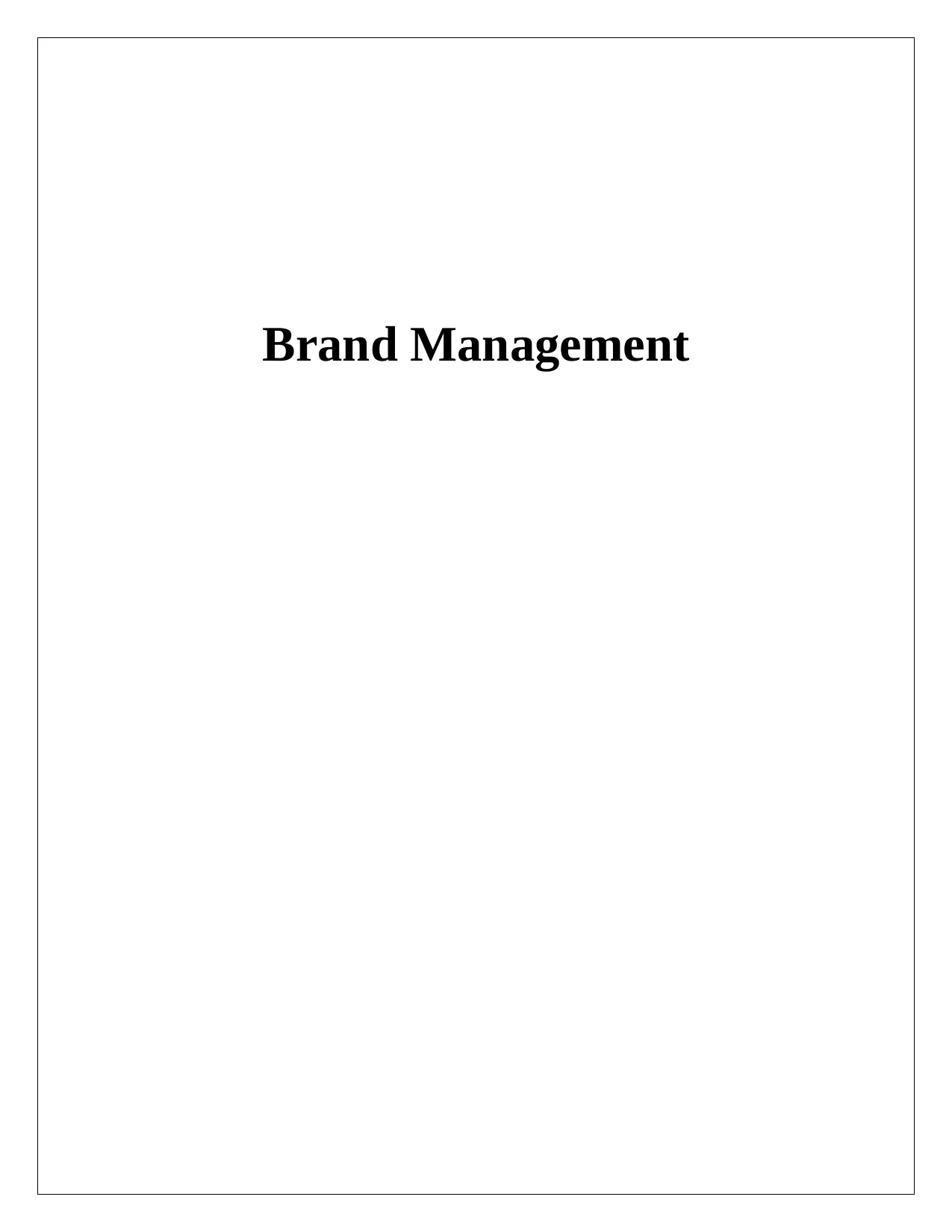
Brand Management
Paraphrase This Document
Need a fresh take? Get an instant paraphrase of this document with our AI Paraphraser
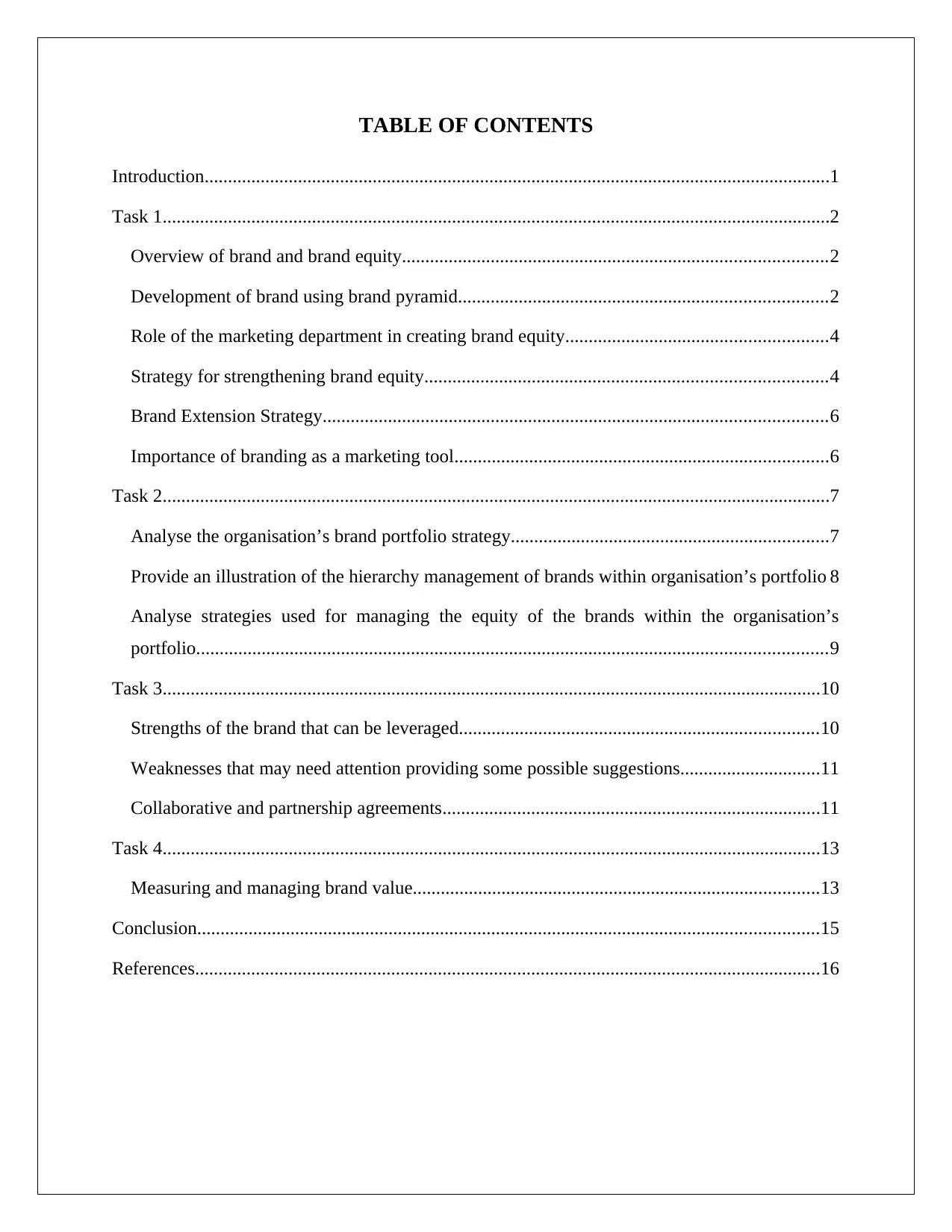
TABLE OF CONTENTS
Introduction......................................................................................................................................1
Task 1...............................................................................................................................................2
Overview of brand and brand equity...........................................................................................2
Development of brand using brand pyramid...............................................................................2
Role of the marketing department in creating brand equity........................................................4
Strategy for strengthening brand equity......................................................................................4
Brand Extension Strategy............................................................................................................6
Importance of branding as a marketing tool................................................................................6
Task 2...............................................................................................................................................7
Analyse the organisation’s brand portfolio strategy....................................................................7
Provide an illustration of the hierarchy management of brands within organisation’s portfolio 8
Analyse strategies used for managing the equity of the brands within the organisation’s
portfolio.......................................................................................................................................9
Task 3.............................................................................................................................................10
Strengths of the brand that can be leveraged.............................................................................10
Weaknesses that may need attention providing some possible suggestions..............................11
Collaborative and partnership agreements.................................................................................11
Task 4.............................................................................................................................................13
Measuring and managing brand value.......................................................................................13
Conclusion.....................................................................................................................................15
References......................................................................................................................................16
Introduction......................................................................................................................................1
Task 1...............................................................................................................................................2
Overview of brand and brand equity...........................................................................................2
Development of brand using brand pyramid...............................................................................2
Role of the marketing department in creating brand equity........................................................4
Strategy for strengthening brand equity......................................................................................4
Brand Extension Strategy............................................................................................................6
Importance of branding as a marketing tool................................................................................6
Task 2...............................................................................................................................................7
Analyse the organisation’s brand portfolio strategy....................................................................7
Provide an illustration of the hierarchy management of brands within organisation’s portfolio 8
Analyse strategies used for managing the equity of the brands within the organisation’s
portfolio.......................................................................................................................................9
Task 3.............................................................................................................................................10
Strengths of the brand that can be leveraged.............................................................................10
Weaknesses that may need attention providing some possible suggestions..............................11
Collaborative and partnership agreements.................................................................................11
Task 4.............................................................................................................................................13
Measuring and managing brand value.......................................................................................13
Conclusion.....................................................................................................................................15
References......................................................................................................................................16
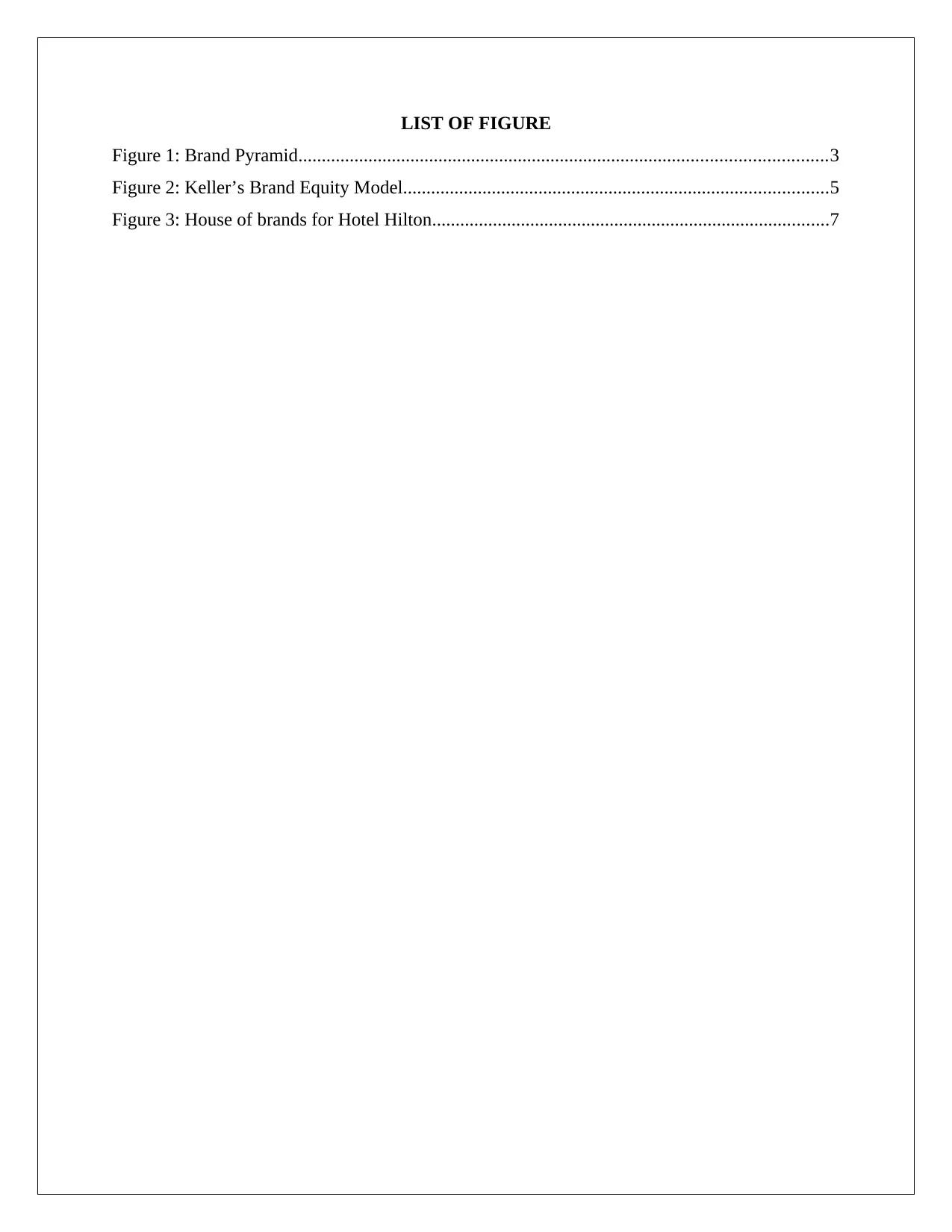
LIST OF FIGURE
Figure 1: Brand Pyramid.................................................................................................................3
Figure 2: Keller’s Brand Equity Model...........................................................................................5
Figure 3: House of brands for Hotel Hilton.....................................................................................7
Figure 1: Brand Pyramid.................................................................................................................3
Figure 2: Keller’s Brand Equity Model...........................................................................................5
Figure 3: House of brands for Hotel Hilton.....................................................................................7
⊘ This is a preview!⊘
Do you want full access?
Subscribe today to unlock all pages.

Trusted by 1+ million students worldwide
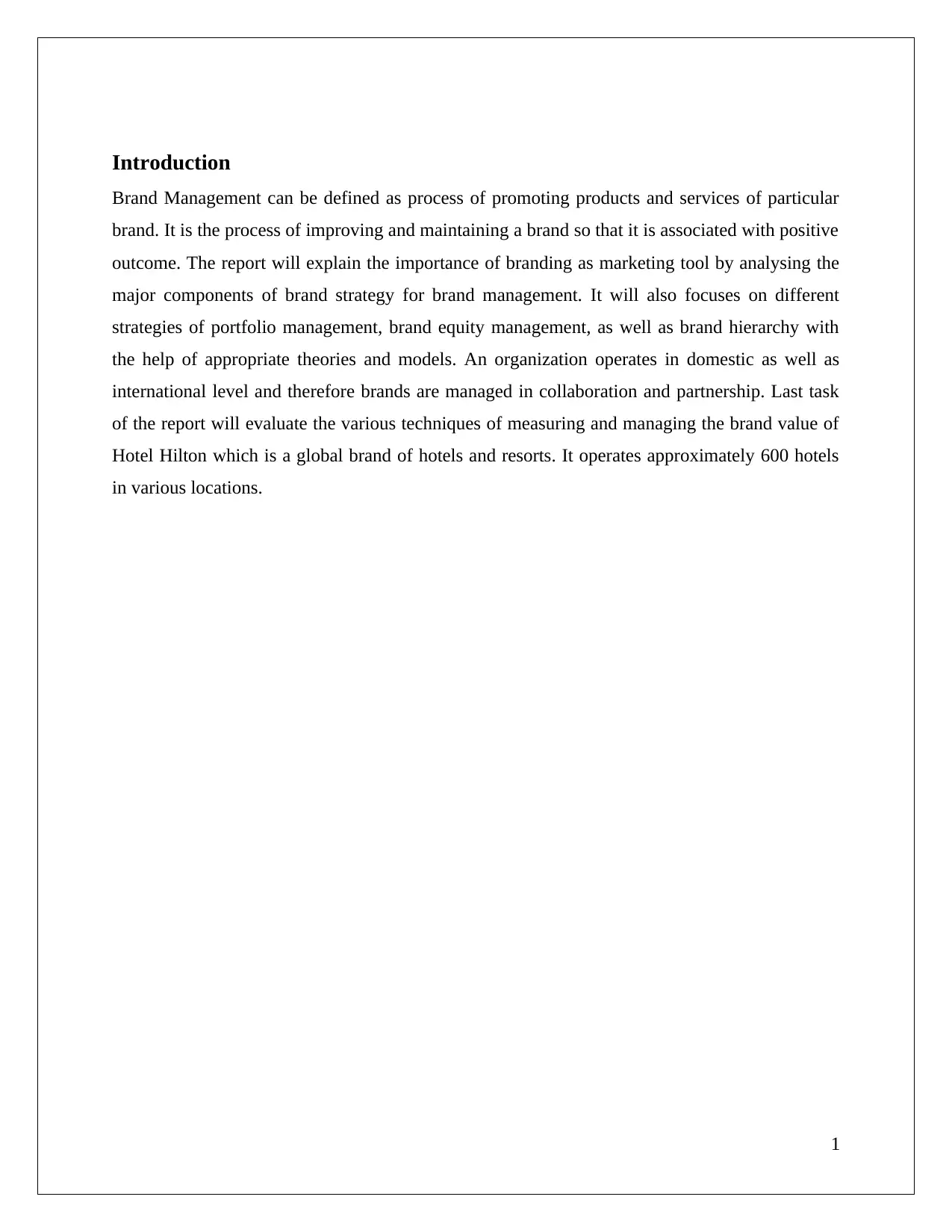
Introduction
Brand Management can be defined as process of promoting products and services of particular
brand. It is the process of improving and maintaining a brand so that it is associated with positive
outcome. The report will explain the importance of branding as marketing tool by analysing the
major components of brand strategy for brand management. It will also focuses on different
strategies of portfolio management, brand equity management, as well as brand hierarchy with
the help of appropriate theories and models. An organization operates in domestic as well as
international level and therefore brands are managed in collaboration and partnership. Last task
of the report will evaluate the various techniques of measuring and managing the brand value of
Hotel Hilton which is a global brand of hotels and resorts. It operates approximately 600 hotels
in various locations.
1
Brand Management can be defined as process of promoting products and services of particular
brand. It is the process of improving and maintaining a brand so that it is associated with positive
outcome. The report will explain the importance of branding as marketing tool by analysing the
major components of brand strategy for brand management. It will also focuses on different
strategies of portfolio management, brand equity management, as well as brand hierarchy with
the help of appropriate theories and models. An organization operates in domestic as well as
international level and therefore brands are managed in collaboration and partnership. Last task
of the report will evaluate the various techniques of measuring and managing the brand value of
Hotel Hilton which is a global brand of hotels and resorts. It operates approximately 600 hotels
in various locations.
1
Paraphrase This Document
Need a fresh take? Get an instant paraphrase of this document with our AI Paraphraser
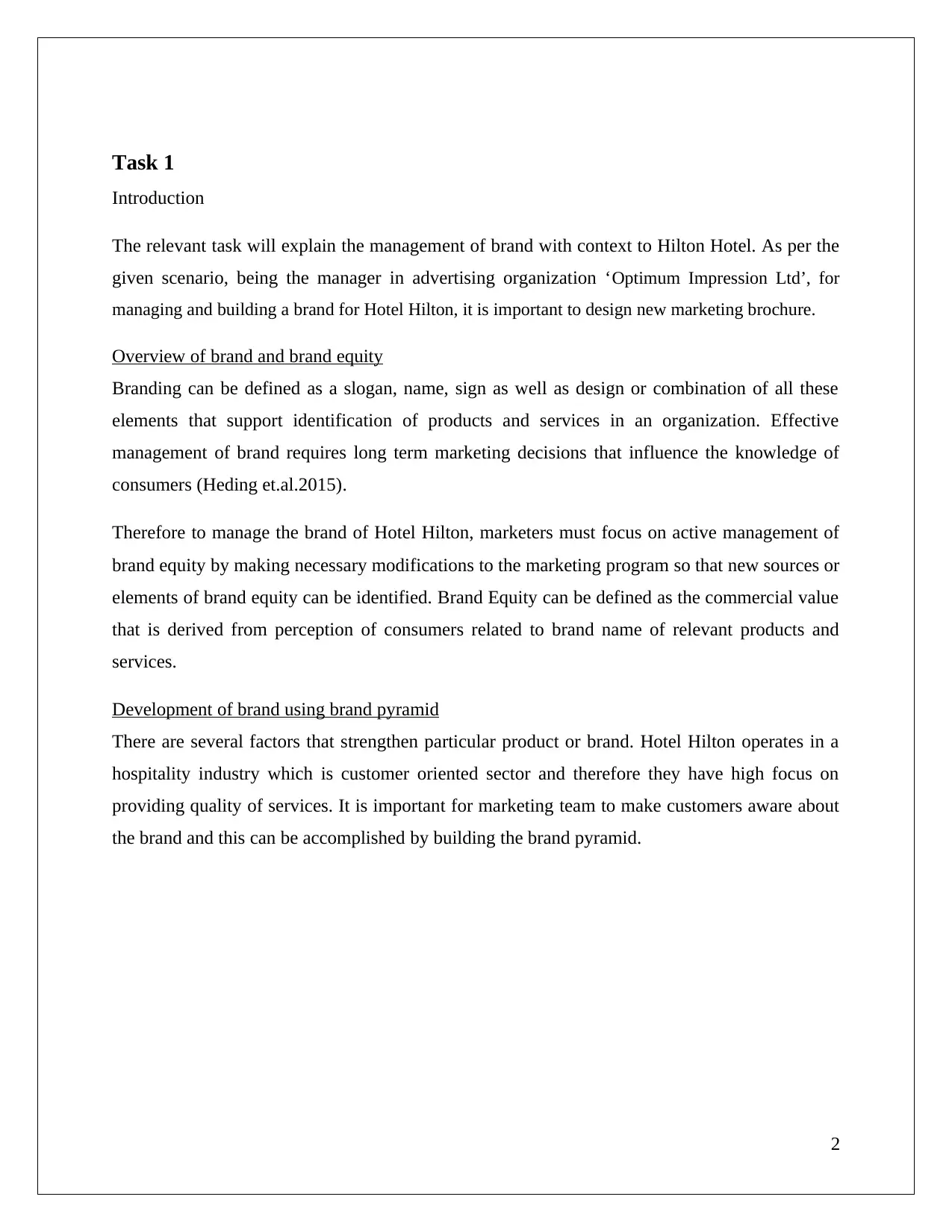
Task 1
Introduction
The relevant task will explain the management of brand with context to Hilton Hotel. As per the
given scenario, being the manager in advertising organization ‘Optimum Impression Ltd’, for
managing and building a brand for Hotel Hilton, it is important to design new marketing brochure.
Overview of brand and brand equity
Branding can be defined as a slogan, name, sign as well as design or combination of all these
elements that support identification of products and services in an organization. Effective
management of brand requires long term marketing decisions that influence the knowledge of
consumers (Heding et.al.2015).
Therefore to manage the brand of Hotel Hilton, marketers must focus on active management of
brand equity by making necessary modifications to the marketing program so that new sources or
elements of brand equity can be identified. Brand Equity can be defined as the commercial value
that is derived from perception of consumers related to brand name of relevant products and
services.
Development of brand using brand pyramid
There are several factors that strengthen particular product or brand. Hotel Hilton operates in a
hospitality industry which is customer oriented sector and therefore they have high focus on
providing quality of services. It is important for marketing team to make customers aware about
the brand and this can be accomplished by building the brand pyramid.
2
Introduction
The relevant task will explain the management of brand with context to Hilton Hotel. As per the
given scenario, being the manager in advertising organization ‘Optimum Impression Ltd’, for
managing and building a brand for Hotel Hilton, it is important to design new marketing brochure.
Overview of brand and brand equity
Branding can be defined as a slogan, name, sign as well as design or combination of all these
elements that support identification of products and services in an organization. Effective
management of brand requires long term marketing decisions that influence the knowledge of
consumers (Heding et.al.2015).
Therefore to manage the brand of Hotel Hilton, marketers must focus on active management of
brand equity by making necessary modifications to the marketing program so that new sources or
elements of brand equity can be identified. Brand Equity can be defined as the commercial value
that is derived from perception of consumers related to brand name of relevant products and
services.
Development of brand using brand pyramid
There are several factors that strengthen particular product or brand. Hotel Hilton operates in a
hospitality industry which is customer oriented sector and therefore they have high focus on
providing quality of services. It is important for marketing team to make customers aware about
the brand and this can be accomplished by building the brand pyramid.
2
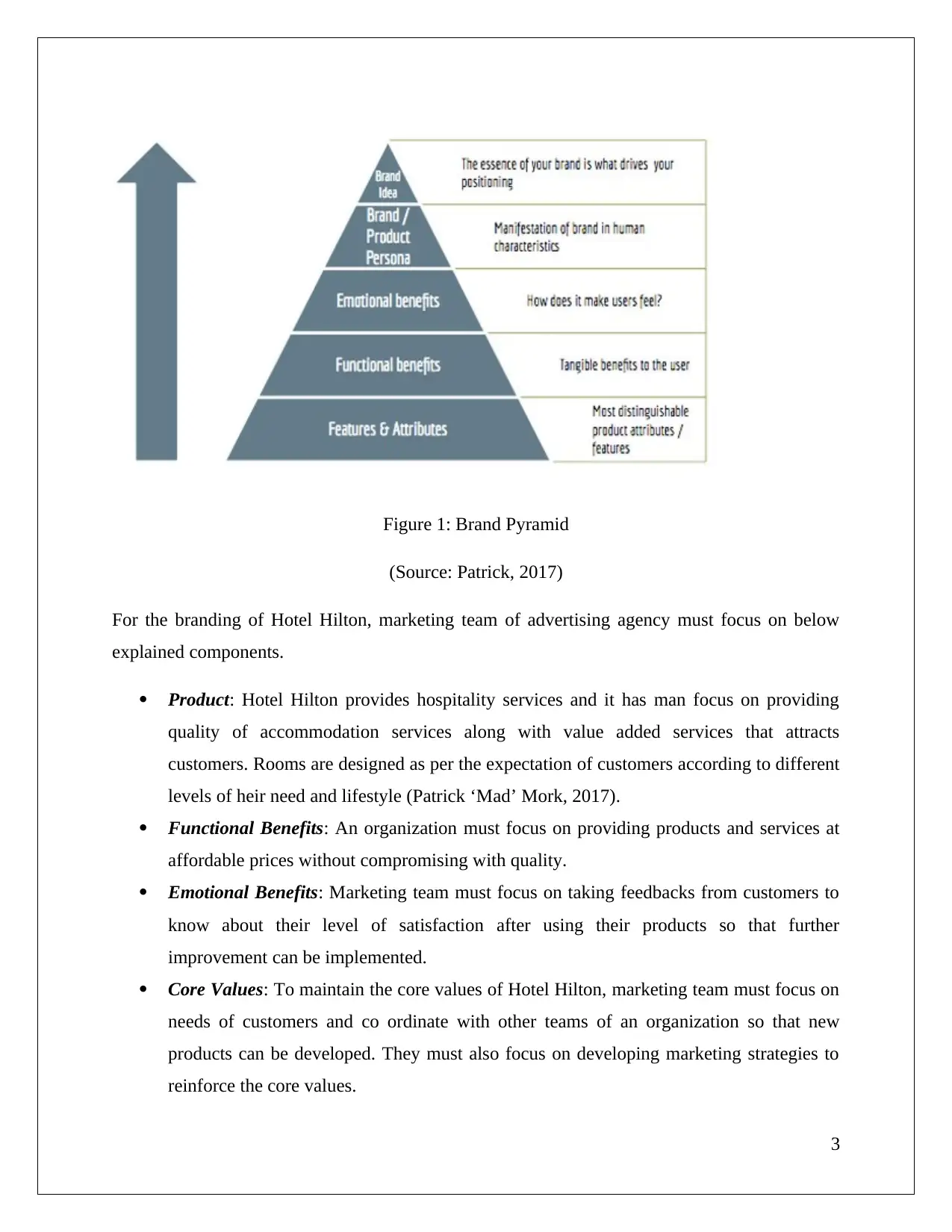
Figure 1: Brand Pyramid
(Source: Patrick, 2017)
For the branding of Hotel Hilton, marketing team of advertising agency must focus on below
explained components.
Product: Hotel Hilton provides hospitality services and it has man focus on providing
quality of accommodation services along with value added services that attracts
customers. Rooms are designed as per the expectation of customers according to different
levels of heir need and lifestyle (Patrick ‘Mad’ Mork, 2017).
Functional Benefits: An organization must focus on providing products and services at
affordable prices without compromising with quality.
Emotional Benefits: Marketing team must focus on taking feedbacks from customers to
know about their level of satisfaction after using their products so that further
improvement can be implemented.
Core Values: To maintain the core values of Hotel Hilton, marketing team must focus on
needs of customers and co ordinate with other teams of an organization so that new
products can be developed. They must also focus on developing marketing strategies to
reinforce the core values.
3
(Source: Patrick, 2017)
For the branding of Hotel Hilton, marketing team of advertising agency must focus on below
explained components.
Product: Hotel Hilton provides hospitality services and it has man focus on providing
quality of accommodation services along with value added services that attracts
customers. Rooms are designed as per the expectation of customers according to different
levels of heir need and lifestyle (Patrick ‘Mad’ Mork, 2017).
Functional Benefits: An organization must focus on providing products and services at
affordable prices without compromising with quality.
Emotional Benefits: Marketing team must focus on taking feedbacks from customers to
know about their level of satisfaction after using their products so that further
improvement can be implemented.
Core Values: To maintain the core values of Hotel Hilton, marketing team must focus on
needs of customers and co ordinate with other teams of an organization so that new
products can be developed. They must also focus on developing marketing strategies to
reinforce the core values.
3
⊘ This is a preview!⊘
Do you want full access?
Subscribe today to unlock all pages.

Trusted by 1+ million students worldwide
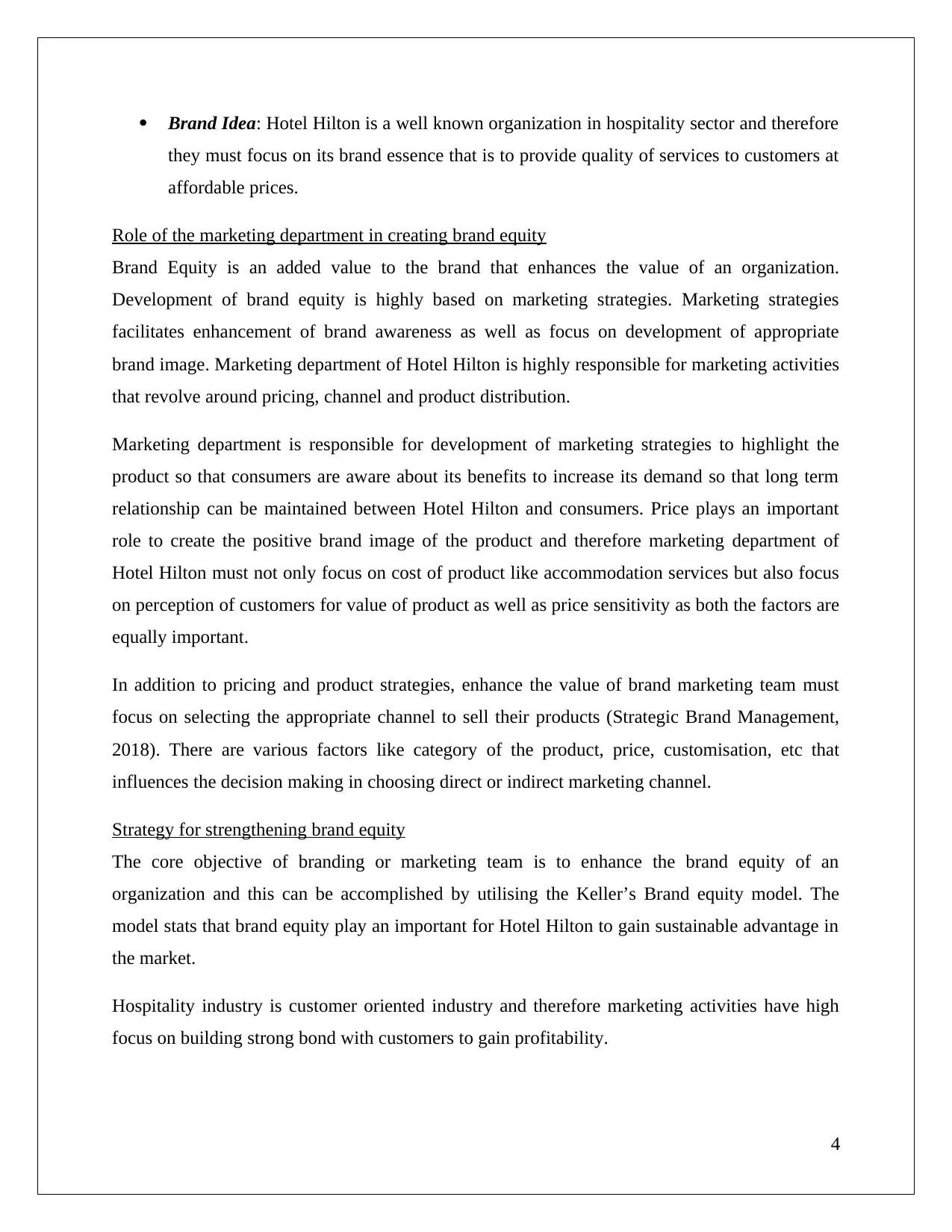
Brand Idea: Hotel Hilton is a well known organization in hospitality sector and therefore
they must focus on its brand essence that is to provide quality of services to customers at
affordable prices.
Role of the marketing department in creating brand equity
Brand Equity is an added value to the brand that enhances the value of an organization.
Development of brand equity is highly based on marketing strategies. Marketing strategies
facilitates enhancement of brand awareness as well as focus on development of appropriate
brand image. Marketing department of Hotel Hilton is highly responsible for marketing activities
that revolve around pricing, channel and product distribution.
Marketing department is responsible for development of marketing strategies to highlight the
product so that consumers are aware about its benefits to increase its demand so that long term
relationship can be maintained between Hotel Hilton and consumers. Price plays an important
role to create the positive brand image of the product and therefore marketing department of
Hotel Hilton must not only focus on cost of product like accommodation services but also focus
on perception of customers for value of product as well as price sensitivity as both the factors are
equally important.
In addition to pricing and product strategies, enhance the value of brand marketing team must
focus on selecting the appropriate channel to sell their products (Strategic Brand Management,
2018). There are various factors like category of the product, price, customisation, etc that
influences the decision making in choosing direct or indirect marketing channel.
Strategy for strengthening brand equity
The core objective of branding or marketing team is to enhance the brand equity of an
organization and this can be accomplished by utilising the Keller’s Brand equity model. The
model stats that brand equity play an important for Hotel Hilton to gain sustainable advantage in
the market.
Hospitality industry is customer oriented industry and therefore marketing activities have high
focus on building strong bond with customers to gain profitability.
4
they must focus on its brand essence that is to provide quality of services to customers at
affordable prices.
Role of the marketing department in creating brand equity
Brand Equity is an added value to the brand that enhances the value of an organization.
Development of brand equity is highly based on marketing strategies. Marketing strategies
facilitates enhancement of brand awareness as well as focus on development of appropriate
brand image. Marketing department of Hotel Hilton is highly responsible for marketing activities
that revolve around pricing, channel and product distribution.
Marketing department is responsible for development of marketing strategies to highlight the
product so that consumers are aware about its benefits to increase its demand so that long term
relationship can be maintained between Hotel Hilton and consumers. Price plays an important
role to create the positive brand image of the product and therefore marketing department of
Hotel Hilton must not only focus on cost of product like accommodation services but also focus
on perception of customers for value of product as well as price sensitivity as both the factors are
equally important.
In addition to pricing and product strategies, enhance the value of brand marketing team must
focus on selecting the appropriate channel to sell their products (Strategic Brand Management,
2018). There are various factors like category of the product, price, customisation, etc that
influences the decision making in choosing direct or indirect marketing channel.
Strategy for strengthening brand equity
The core objective of branding or marketing team is to enhance the brand equity of an
organization and this can be accomplished by utilising the Keller’s Brand equity model. The
model stats that brand equity play an important for Hotel Hilton to gain sustainable advantage in
the market.
Hospitality industry is customer oriented industry and therefore marketing activities have high
focus on building strong bond with customers to gain profitability.
4
Paraphrase This Document
Need a fresh take? Get an instant paraphrase of this document with our AI Paraphraser
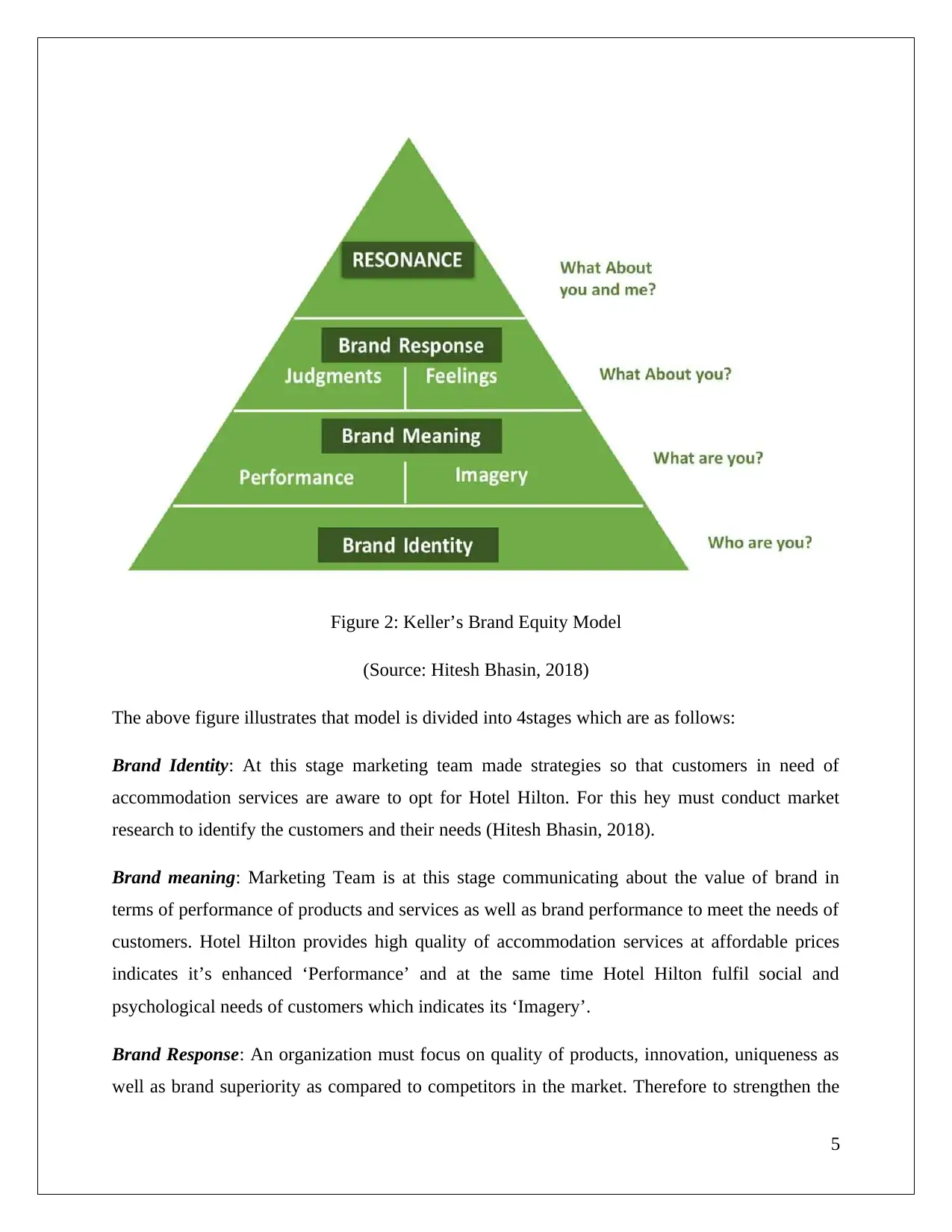
Figure 2: Keller’s Brand Equity Model
(Source: Hitesh Bhasin, 2018)
The above figure illustrates that model is divided into 4stages which are as follows:
Brand Identity: At this stage marketing team made strategies so that customers in need of
accommodation services are aware to opt for Hotel Hilton. For this hey must conduct market
research to identify the customers and their needs (Hitesh Bhasin, 2018).
Brand meaning: Marketing Team is at this stage communicating about the value of brand in
terms of performance of products and services as well as brand performance to meet the needs of
customers. Hotel Hilton provides high quality of accommodation services at affordable prices
indicates it’s enhanced ‘Performance’ and at the same time Hotel Hilton fulfil social and
psychological needs of customers which indicates its ‘Imagery’.
Brand Response: An organization must focus on quality of products, innovation, uniqueness as
well as brand superiority as compared to competitors in the market. Therefore to strengthen the
5
(Source: Hitesh Bhasin, 2018)
The above figure illustrates that model is divided into 4stages which are as follows:
Brand Identity: At this stage marketing team made strategies so that customers in need of
accommodation services are aware to opt for Hotel Hilton. For this hey must conduct market
research to identify the customers and their needs (Hitesh Bhasin, 2018).
Brand meaning: Marketing Team is at this stage communicating about the value of brand in
terms of performance of products and services as well as brand performance to meet the needs of
customers. Hotel Hilton provides high quality of accommodation services at affordable prices
indicates it’s enhanced ‘Performance’ and at the same time Hotel Hilton fulfil social and
psychological needs of customers which indicates its ‘Imagery’.
Brand Response: An organization must focus on quality of products, innovation, uniqueness as
well as brand superiority as compared to competitors in the market. Therefore to strengthen the
5
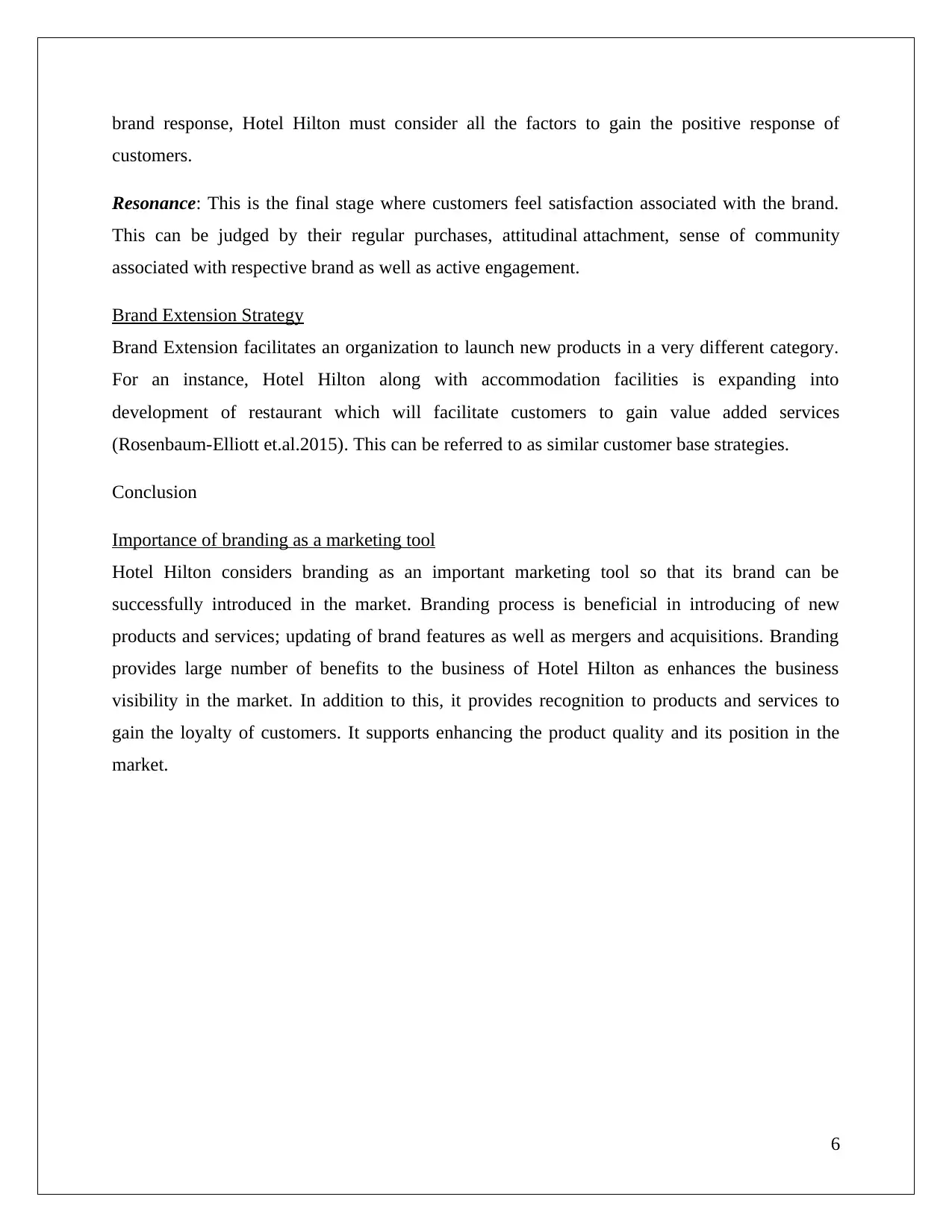
brand response, Hotel Hilton must consider all the factors to gain the positive response of
customers.
Resonance: This is the final stage where customers feel satisfaction associated with the brand.
This can be judged by their regular purchases, attitudinal attachment, sense of community
associated with respective brand as well as active engagement.
Brand Extension Strategy
Brand Extension facilitates an organization to launch new products in a very different category.
For an instance, Hotel Hilton along with accommodation facilities is expanding into
development of restaurant which will facilitate customers to gain value added services
(Rosenbaum-Elliott et.al.2015). This can be referred to as similar customer base strategies.
Conclusion
Importance of branding as a marketing tool
Hotel Hilton considers branding as an important marketing tool so that its brand can be
successfully introduced in the market. Branding process is beneficial in introducing of new
products and services; updating of brand features as well as mergers and acquisitions. Branding
provides large number of benefits to the business of Hotel Hilton as enhances the business
visibility in the market. In addition to this, it provides recognition to products and services to
gain the loyalty of customers. It supports enhancing the product quality and its position in the
market.
6
customers.
Resonance: This is the final stage where customers feel satisfaction associated with the brand.
This can be judged by their regular purchases, attitudinal attachment, sense of community
associated with respective brand as well as active engagement.
Brand Extension Strategy
Brand Extension facilitates an organization to launch new products in a very different category.
For an instance, Hotel Hilton along with accommodation facilities is expanding into
development of restaurant which will facilitate customers to gain value added services
(Rosenbaum-Elliott et.al.2015). This can be referred to as similar customer base strategies.
Conclusion
Importance of branding as a marketing tool
Hotel Hilton considers branding as an important marketing tool so that its brand can be
successfully introduced in the market. Branding process is beneficial in introducing of new
products and services; updating of brand features as well as mergers and acquisitions. Branding
provides large number of benefits to the business of Hotel Hilton as enhances the business
visibility in the market. In addition to this, it provides recognition to products and services to
gain the loyalty of customers. It supports enhancing the product quality and its position in the
market.
6
⊘ This is a preview!⊘
Do you want full access?
Subscribe today to unlock all pages.

Trusted by 1+ million students worldwide
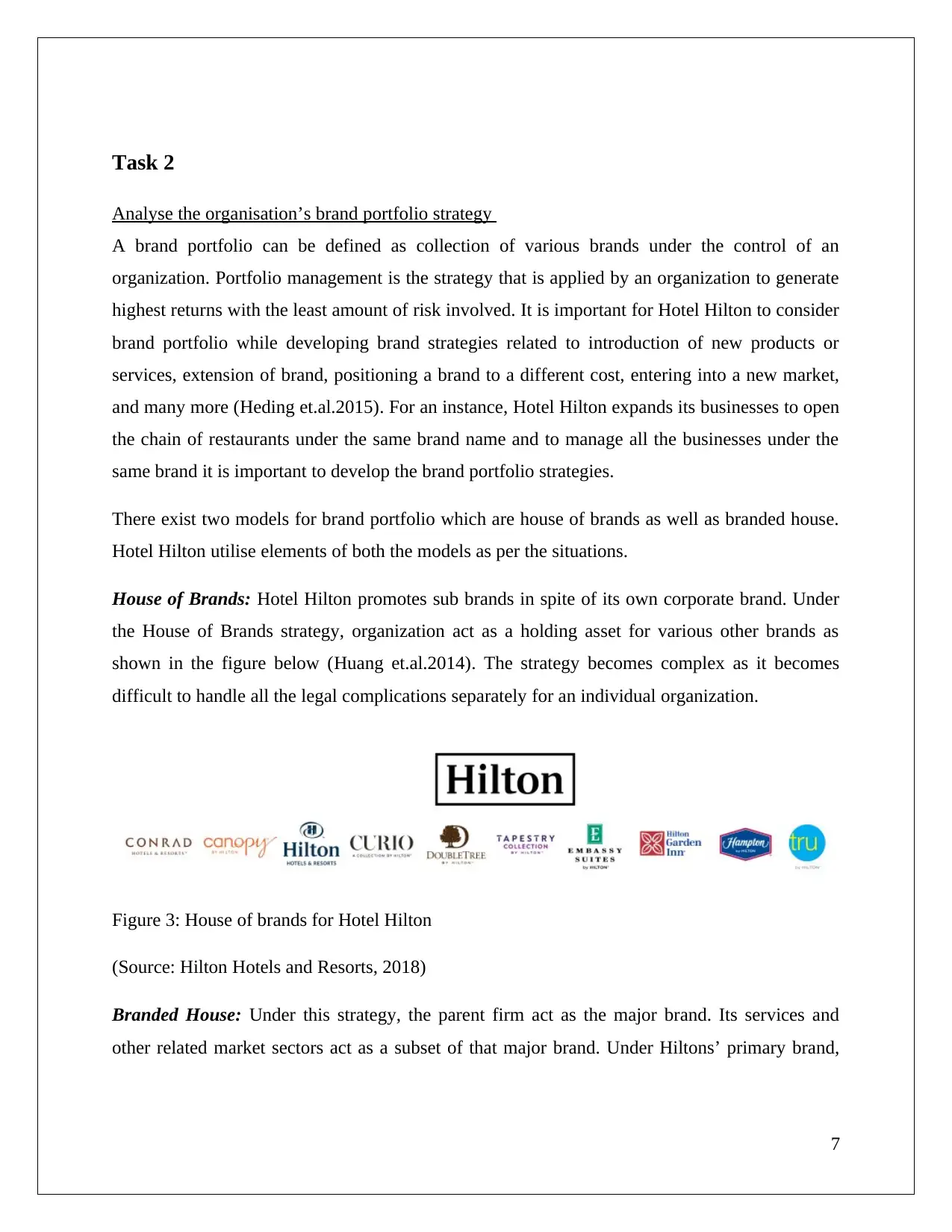
Task 2
Analyse the organisation’s brand portfolio strategy
A brand portfolio can be defined as collection of various brands under the control of an
organization. Portfolio management is the strategy that is applied by an organization to generate
highest returns with the least amount of risk involved. It is important for Hotel Hilton to consider
brand portfolio while developing brand strategies related to introduction of new products or
services, extension of brand, positioning a brand to a different cost, entering into a new market,
and many more (Heding et.al.2015). For an instance, Hotel Hilton expands its businesses to open
the chain of restaurants under the same brand name and to manage all the businesses under the
same brand it is important to develop the brand portfolio strategies.
There exist two models for brand portfolio which are house of brands as well as branded house.
Hotel Hilton utilise elements of both the models as per the situations.
House of Brands: Hotel Hilton promotes sub brands in spite of its own corporate brand. Under
the House of Brands strategy, organization act as a holding asset for various other brands as
shown in the figure below (Huang et.al.2014). The strategy becomes complex as it becomes
difficult to handle all the legal complications separately for an individual organization.
Figure 3: House of brands for Hotel Hilton
(Source: Hilton Hotels and Resorts, 2018)
Branded House: Under this strategy, the parent firm act as the major brand. Its services and
other related market sectors act as a subset of that major brand. Under Hiltons’ primary brand,
7
Analyse the organisation’s brand portfolio strategy
A brand portfolio can be defined as collection of various brands under the control of an
organization. Portfolio management is the strategy that is applied by an organization to generate
highest returns with the least amount of risk involved. It is important for Hotel Hilton to consider
brand portfolio while developing brand strategies related to introduction of new products or
services, extension of brand, positioning a brand to a different cost, entering into a new market,
and many more (Heding et.al.2015). For an instance, Hotel Hilton expands its businesses to open
the chain of restaurants under the same brand name and to manage all the businesses under the
same brand it is important to develop the brand portfolio strategies.
There exist two models for brand portfolio which are house of brands as well as branded house.
Hotel Hilton utilise elements of both the models as per the situations.
House of Brands: Hotel Hilton promotes sub brands in spite of its own corporate brand. Under
the House of Brands strategy, organization act as a holding asset for various other brands as
shown in the figure below (Huang et.al.2014). The strategy becomes complex as it becomes
difficult to handle all the legal complications separately for an individual organization.
Figure 3: House of brands for Hotel Hilton
(Source: Hilton Hotels and Resorts, 2018)
Branded House: Under this strategy, the parent firm act as the major brand. Its services and
other related market sectors act as a subset of that major brand. Under Hiltons’ primary brand,
7
Paraphrase This Document
Need a fresh take? Get an instant paraphrase of this document with our AI Paraphraser
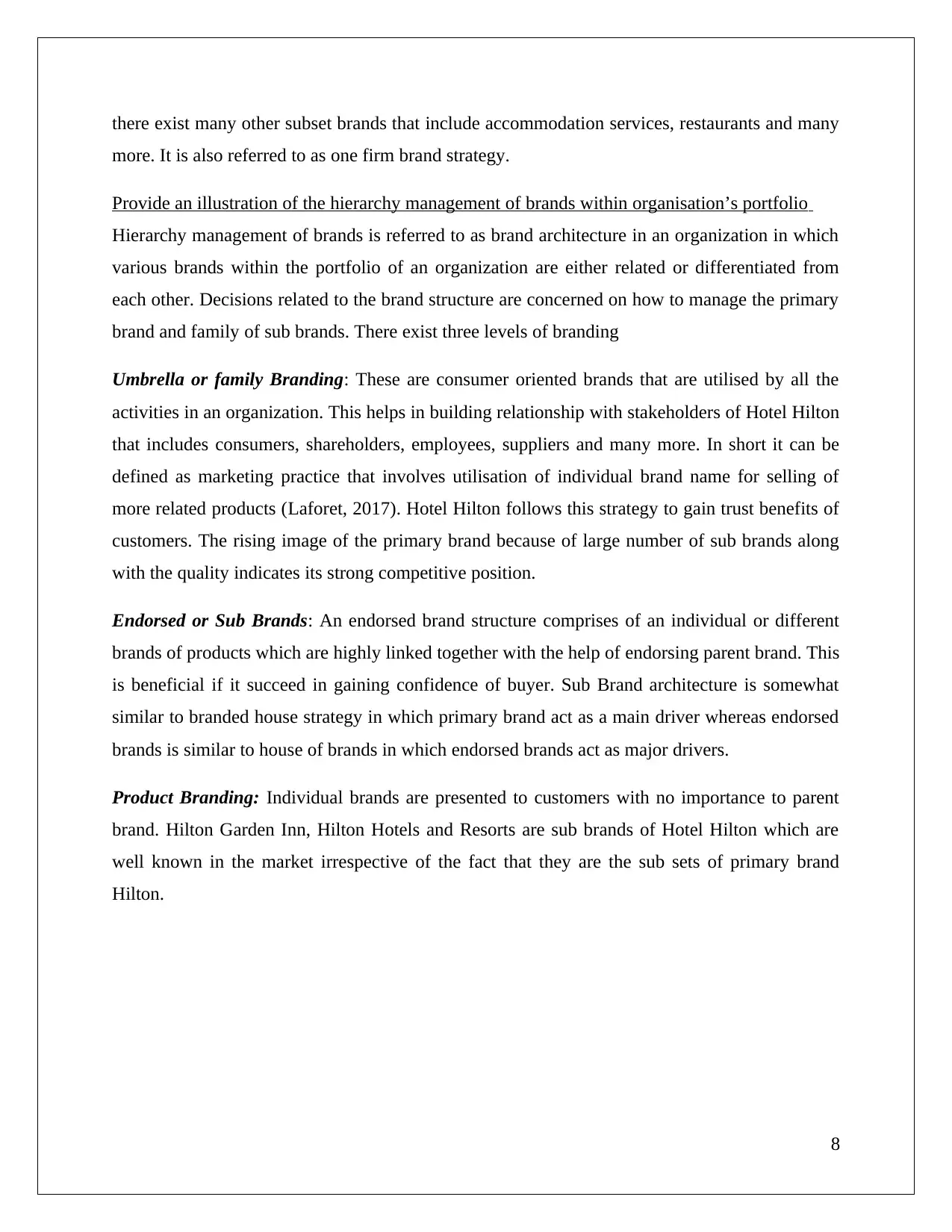
there exist many other subset brands that include accommodation services, restaurants and many
more. It is also referred to as one firm brand strategy.
Provide an illustration of the hierarchy management of brands within organisation’s portfolio
Hierarchy management of brands is referred to as brand architecture in an organization in which
various brands within the portfolio of an organization are either related or differentiated from
each other. Decisions related to the brand structure are concerned on how to manage the primary
brand and family of sub brands. There exist three levels of branding
Umbrella or family Branding: These are consumer oriented brands that are utilised by all the
activities in an organization. This helps in building relationship with stakeholders of Hotel Hilton
that includes consumers, shareholders, employees, suppliers and many more. In short it can be
defined as marketing practice that involves utilisation of individual brand name for selling of
more related products (Laforet, 2017). Hotel Hilton follows this strategy to gain trust benefits of
customers. The rising image of the primary brand because of large number of sub brands along
with the quality indicates its strong competitive position.
Endorsed or Sub Brands: An endorsed brand structure comprises of an individual or different
brands of products which are highly linked together with the help of endorsing parent brand. This
is beneficial if it succeed in gaining confidence of buyer. Sub Brand architecture is somewhat
similar to branded house strategy in which primary brand act as a main driver whereas endorsed
brands is similar to house of brands in which endorsed brands act as major drivers.
Product Branding: Individual brands are presented to customers with no importance to parent
brand. Hilton Garden Inn, Hilton Hotels and Resorts are sub brands of Hotel Hilton which are
well known in the market irrespective of the fact that they are the sub sets of primary brand
Hilton.
8
more. It is also referred to as one firm brand strategy.
Provide an illustration of the hierarchy management of brands within organisation’s portfolio
Hierarchy management of brands is referred to as brand architecture in an organization in which
various brands within the portfolio of an organization are either related or differentiated from
each other. Decisions related to the brand structure are concerned on how to manage the primary
brand and family of sub brands. There exist three levels of branding
Umbrella or family Branding: These are consumer oriented brands that are utilised by all the
activities in an organization. This helps in building relationship with stakeholders of Hotel Hilton
that includes consumers, shareholders, employees, suppliers and many more. In short it can be
defined as marketing practice that involves utilisation of individual brand name for selling of
more related products (Laforet, 2017). Hotel Hilton follows this strategy to gain trust benefits of
customers. The rising image of the primary brand because of large number of sub brands along
with the quality indicates its strong competitive position.
Endorsed or Sub Brands: An endorsed brand structure comprises of an individual or different
brands of products which are highly linked together with the help of endorsing parent brand. This
is beneficial if it succeed in gaining confidence of buyer. Sub Brand architecture is somewhat
similar to branded house strategy in which primary brand act as a main driver whereas endorsed
brands is similar to house of brands in which endorsed brands act as major drivers.
Product Branding: Individual brands are presented to customers with no importance to parent
brand. Hilton Garden Inn, Hilton Hotels and Resorts are sub brands of Hotel Hilton which are
well known in the market irrespective of the fact that they are the sub sets of primary brand
Hilton.
8
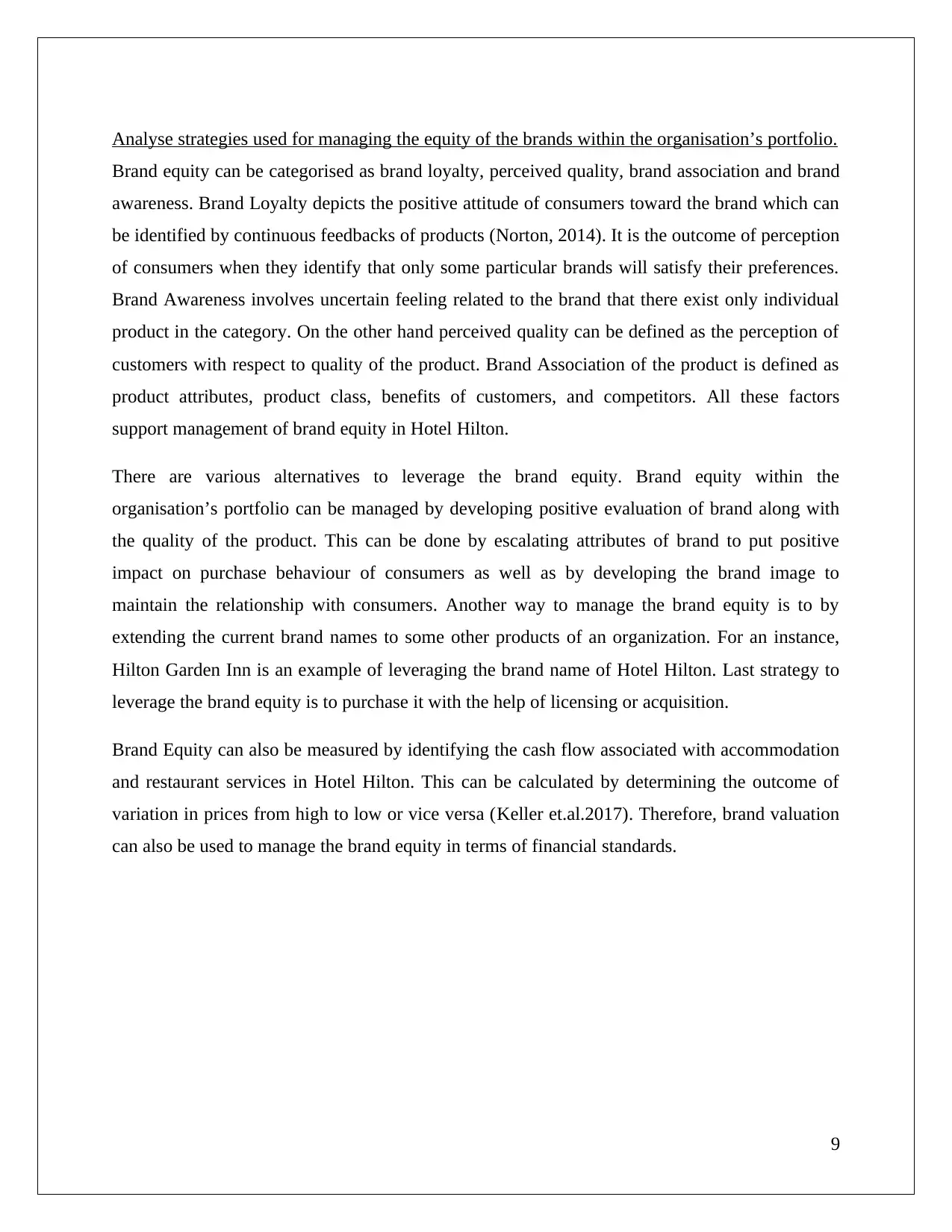
Analyse strategies used for managing the equity of the brands within the organisation’s portfolio.
Brand equity can be categorised as brand loyalty, perceived quality, brand association and brand
awareness. Brand Loyalty depicts the positive attitude of consumers toward the brand which can
be identified by continuous feedbacks of products (Norton, 2014). It is the outcome of perception
of consumers when they identify that only some particular brands will satisfy their preferences.
Brand Awareness involves uncertain feeling related to the brand that there exist only individual
product in the category. On the other hand perceived quality can be defined as the perception of
customers with respect to quality of the product. Brand Association of the product is defined as
product attributes, product class, benefits of customers, and competitors. All these factors
support management of brand equity in Hotel Hilton.
There are various alternatives to leverage the brand equity. Brand equity within the
organisation’s portfolio can be managed by developing positive evaluation of brand along with
the quality of the product. This can be done by escalating attributes of brand to put positive
impact on purchase behaviour of consumers as well as by developing the brand image to
maintain the relationship with consumers. Another way to manage the brand equity is to by
extending the current brand names to some other products of an organization. For an instance,
Hilton Garden Inn is an example of leveraging the brand name of Hotel Hilton. Last strategy to
leverage the brand equity is to purchase it with the help of licensing or acquisition.
Brand Equity can also be measured by identifying the cash flow associated with accommodation
and restaurant services in Hotel Hilton. This can be calculated by determining the outcome of
variation in prices from high to low or vice versa (Keller et.al.2017). Therefore, brand valuation
can also be used to manage the brand equity in terms of financial standards.
9
Brand equity can be categorised as brand loyalty, perceived quality, brand association and brand
awareness. Brand Loyalty depicts the positive attitude of consumers toward the brand which can
be identified by continuous feedbacks of products (Norton, 2014). It is the outcome of perception
of consumers when they identify that only some particular brands will satisfy their preferences.
Brand Awareness involves uncertain feeling related to the brand that there exist only individual
product in the category. On the other hand perceived quality can be defined as the perception of
customers with respect to quality of the product. Brand Association of the product is defined as
product attributes, product class, benefits of customers, and competitors. All these factors
support management of brand equity in Hotel Hilton.
There are various alternatives to leverage the brand equity. Brand equity within the
organisation’s portfolio can be managed by developing positive evaluation of brand along with
the quality of the product. This can be done by escalating attributes of brand to put positive
impact on purchase behaviour of consumers as well as by developing the brand image to
maintain the relationship with consumers. Another way to manage the brand equity is to by
extending the current brand names to some other products of an organization. For an instance,
Hilton Garden Inn is an example of leveraging the brand name of Hotel Hilton. Last strategy to
leverage the brand equity is to purchase it with the help of licensing or acquisition.
Brand Equity can also be measured by identifying the cash flow associated with accommodation
and restaurant services in Hotel Hilton. This can be calculated by determining the outcome of
variation in prices from high to low or vice versa (Keller et.al.2017). Therefore, brand valuation
can also be used to manage the brand equity in terms of financial standards.
9
⊘ This is a preview!⊘
Do you want full access?
Subscribe today to unlock all pages.

Trusted by 1+ million students worldwide
1 out of 20
Related Documents
Your All-in-One AI-Powered Toolkit for Academic Success.
+13062052269
info@desklib.com
Available 24*7 on WhatsApp / Email
![[object Object]](/_next/static/media/star-bottom.7253800d.svg)
Unlock your academic potential
Copyright © 2020–2025 A2Z Services. All Rights Reserved. Developed and managed by ZUCOL.